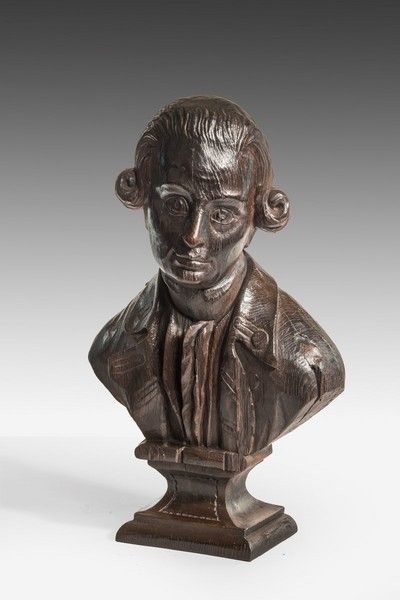Major John Andre.
A Carved Oak bust.
Possibly 18th Century.
English or American
Possibly 18th Century.
English or American
with Dealers Coulborn of Sutton Coldfield.
https://www.coulborn.com/
https://www.coulborn.com/furniture-categories/paintings-and-sculpture/late-18th-century-carved-oak-bust-of-major-john-andre/
I am very grateful to Messrs Coulborn for allowing me to use their photographs.
I have been in contact with Coulborns who tell me that the Andre identification is traditional
The timber has not been tested.
I am very grateful to Messrs Coulborn for allowing me to use their photographs.
I have been in contact with Coulborns who tell me that the Andre identification is traditional
The timber has not been tested.
__________________
Height: 250 millimetres
Width: 167 millimetres
Lettered above and below image "Engraved for Raymond's
History of England" "Dodd delin." "Cook sculp." and
"Major John Andre Late Adjutant General to the British Army in North
America"
___________________
The monument of Major John André; a sarcophagus surmounted
by a figure of Britannia, with a bas-relief showing a man handing a petition to
George Washington on behalf of André, who is being led away to execution as a
spy on the right; with a lettered plaque on the plinth; framed in an arch
within a rectangle with a decorated border; André's letter to Washington
reproduced below the image.
1783 Etching and engraving.
The plaque on the monument reads 'Sacred to the Memory of
Major John André, Who raised [sic] by his Merit, at an early Period of Life, to
the Rank of Adjutant General of the British Forces in America, & employed
in an Important but hazardous Enterprise, fell a Sacrifice to his Zeal for his
King & Country on the 2nd. of October, 1780, Aged 29. universally beloved
and esteemed by the Army in which he seved, & lamented even by his Foes.
His Gracious Sovereign King George IIId has caused this Momnnument to be
erected.'
The letter on the engraving reads: 'Tappan, Oct. 1. 1780. / Sir Buoy'd above
the terror of death, by the consciousness of a life devoted to honourable
pursuits, & stained with no action that can give me remorse, I trust that
the request I make to your Excellency at this serious period, & which is to
soften my last moments, will not be rejected. Sympathy towards a soldier will
surely induce your Excellency, and a military tribunal to adapt the mode of my
death to the feelings of a Man of honour. Let me hope, Sir, that if aught in my
character, impresses you with esteem towards me, if aught in my misfortunes
marks me as the Victim of policy and not of resentment, I shall experience the
operation of these feelings in your breast, by being informed that I am not to
die on a Gibbet. / I have the honour to be, Your Excellency's most obedient and
Most humble servant. John André. / Adjutant General to the British Army. /
General Washington.'
© The Trustees of the British Museum.
Monument in Westminster Abbey
Designed by Robert Adam and carved by Peter Matthias Vangelder (van Gelder) c.1742 - 1809.
Designed by Robert Adam and carved by Peter Matthias Vangelder (van Gelder) c.1742 - 1809.
Photo Credit: © Westminster Abbey.
Image taken from
https://www.guidelondon.org.uk/blog/british-military/memorial-at-westminster-abbey-for-major-john-andre/
For Vangelder's works see entry below lifted from -
http://liberty.henry-moore.org/henrymoore/sculptor/browserecord.php?-action=browse&-recid=2787
For Vangelder's works see entry below lifted from -
http://liberty.henry-moore.org/henrymoore/sculptor/browserecord.php?-action=browse&-recid=2787
| |||||||
________________________
The Adam drawings in the Soane Museum for the Monument in Westminster Abbey to Major John Andre
Drawing from the Adam Office
SM Adam Volume 19/32
http://collections.soane.org/THES87574
Photo: © Sir John Soane’s Museum, London.
_____________
Reference number SM Adam Volume 19/31
Adam office, Andre Monument
© Sir John Soane's Museum.
____________________________
Reference number SM Adam Volume 19/30
Adam office, Andre Monument
© Sir John Soane's Museum
____________________________
Reference number SM Adam Volume 19/29
Adam office, Andre Monument
© Sir John Soane's Museum
________________
For a good brief biog of Major Andre see -
https://allthingsliberty.com/2018/08/the-death-and-resurrection-of-major-john-andre/













No comments:
Post a Comment